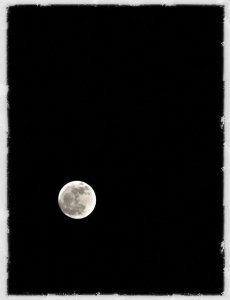 Quite coincidentally, given the moon hour-by-hour video I posted earlier today, a press release just arrived waxing lyrical about gazing up at the night sky and seeing the familiar face of the “Man in the Moon”. The synchronous rotation of the Moon means it takes about the same amount of time to rotate on its axis as it does to orbit once around the Earth, which means the Moon’s “eyes” are always fixed in our direction, in other words the familiar hemisphere is always facing Earth. The “dark” side of the moon is not, as a matter of fact dark, it is frequently exposed to sunlight, it’s just that we don’t see it from Earth. But why was it the “facial” side of the Moon that ended up locked facing the Earth?
Quite coincidentally, given the moon hour-by-hour video I posted earlier today, a press release just arrived waxing lyrical about gazing up at the night sky and seeing the familiar face of the “Man in the Moon”. The synchronous rotation of the Moon means it takes about the same amount of time to rotate on its axis as it does to orbit once around the Earth, which means the Moon’s “eyes” are always fixed in our direction, in other words the familiar hemisphere is always facing Earth. The “dark” side of the moon is not, as a matter of fact dark, it is frequently exposed to sunlight, it’s just that we don’t see it from Earth. But why was it the “facial” side of the Moon that ended up locked facing the Earth?
Oded Aharonson of the Weizmann Institute of Science, Peter Goldreich of Caltech and Re’em Sari of the Hebrew University of Jerusalem suggest it is not mere coincidence. The face faces us because it is low-lying and covered with craters. By contrast, the far side is predominately mountainous. “Intuitively, we might actually have expected the far side to be facing us as the high mountains, as opposed to the low craters, would have brought the Moon closer to Earth, putting the system in a lower energy state,” says Aharonson. Nature usually prefers lower energy states, so why isn’t this the case?
The motion of the Moon is a bit like the motion of a toy train circling around a track with two hills and two valleys. The hills and valleys represent the different energy levels of the orientation of the geophysically asymmetric Moon. Because of friction, the train continues to lose energy until it doesn’t have enough to climb over the hill, thus it settles into one of the valleys – facing Earth or facing away from Earth. The valley “chosen” is governed not by the depth of either valley, but by the height of the hill it had to cross to get there. In other words, when it ran out of steam it could no longer get over the “hill” and settled into the energy valley before that higher hill.